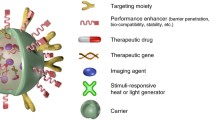Abstract
DNA-polymer conjugates have been recognized as versatile functional materials in many different fields ranging from nanotechnology to diagnostics and biomedicine. They combine the favorable properties of nucleic acids and synthetic polymers. Moreover, joining both structures with covalent bonds to form bioorganic hybrids allows for the tuning of specific properties or even the possibility of evolving completely new functions. One important class of this type of material is amphiphilic DNA block copolymers, which, due to microphase separation, can spontaneously adopt nanosized micelle morphologies with a hydrophobic core and a DNA corona. These DNA nano-objects have been explored as vehicles for targeted gene and drug delivery, and also as programmable nanoreactors for organic reactions. Key to the successful realization of these potential applications is that (1) DNA block copolymer conjugates can be fabricated in a fully automated fashion by employing a DNA synthesizer; (2) hydrophobic compounds can be loaded within their interior; and (3) they can be site-specifically functionalized by a convenient nucleic acid hybridization procedure. This chapter aims to broaden the range of biodiagnostic and biomedical applications of these materials by providing a comprehensive outline of the preparation and characterization of multifunctional DNA-polymer nanoparticles.
Access this chapter
Tax calculation will be finalised at checkout
Purchases are for personal use only
Similar content being viewed by others
References
Lemaitre M., Bayard B., Lebleu B. (1987) Specific antiviral activity of a poly(L-lysine)-conjugated oligodeoxyribonucleotide sequence complementary to vesicular stomatitis virus N protein mRNA initiation site. Proc. Natl. Acad. Sci. USA 84, 648–52.
Yang C. Y. J., Pinto M., Schanze K., Tan W. H. (2005) Direct synthesis of an oligonucleotide-poly(phenylene ethynylene) conjugate with a precise one-to-one molecular ratio. Angew. Chem. Int. Ed. 44, 2572–6.
Costioli M. D., Fisch I., Garret-Flaudy F., Hilbrig F., Freitag R. (2003) DNA purification by triple-helix affinity precipitation. Biotechnol. Bioeng. 81, 535–45.
Soh N., Umeno D., Tang Z. L., Murata M., Maeda M. (2002) Affinity precipitation separation of DNA binding protein using block conjugate composed of poly(N-isopropylacrylamide) grafted double-stranded DNA and double-stranded DNA containing a target sequence. Anal. Sci. 18, 1295–9.
The Eyetec Study Group (2002) Preclinical and phase 1A clinical evaluation of an anti-VEGF pegylated aptamer (EYE001) for the treatment of exudative age-related macular degeneration. Retina 22, 143–52.
Oishi M., Nagatsugi F., Sasaki S., Nagasaki Y., Kataoka K. (2005) Smart polyion complex micelles for targeted intracellular delivery of PEGylated antisense oligonucleotides containing acid-labile linkages. ChemBioChem 6, 718–25.
Jeong J. H., Kim S. W., Park T. G. (2003) A new antisense oligonucleotide delivery system based on self-assembled ODN-PEG hybrid conjugate micelles. J. Control. Release 183–91.
Kim S. H., Jeong J. H., Lee S. H., Kim S. W., Park T. G. (2008) Local and systemic delivery of VEGF siRNA using polyelectrolyte complex micelles for effective treatment of cancer. J. Control. Release 129, 107–16.
Alemdaroglu F. E., Herrmann A. (2007) DNA meets synthetic polymers – highly versatile hybrid materials. Org. Biomol. Chem. 5, 1311–20.
Alemdaroglu F. E., Ding K., Berger R., Herrmann A. (2006) DNA-templated synthesis in three dimensions: Introducing a micellar scaffold for organic reactions. Angew. Chem. Int. Ed. 45, 4206–10.
Safak M., Alemdaroglu F. E., Li Y., Ergen E., Herrmann A. (2007) Polymerase chain reaction as an efficient tool for the preparation of block copolymers. Adv. Mater. 19 1499–505.
Alemdaroglu F. E., Zhuang W., Zöphel L., et al. (2009) Generation of Multiblock copolymers by PCR: synthesis, visualization and nanomechanical properties. Nano Lett. 9, 3658–62.
Ding K., Alemdaroglu F. E., Börsch M., Berger R., Herrmann A. (2007) Engineering the structural properties of DNA block copolymer micelles by molecular recognition. Angew. Chem. Int. Ed. 46, 1172–5.
Alemdaroglu F. E., Wang J., Börsch M., Berger R., Herrmann A. (2008) Enzymatic control of the size of DNA block copolymer nanoparticles. Angew. Chem. Int. Ed. 47, 974–6.
Alemdaroglu F. E., Alemdaroglu C. N., Langguth P., Herrmann A. (2008) Shape dependent cellular uptake of dna nanoparticles. Macromol. Rapid. Commun. 29, 326–9.
Alemdaroglu F. E., Alemdaroglu C. N., Langguth P., Herrmann A. (2008) DNA Block copolymer micelles - A combinatorial tool for cancer nanotechnology. Adv. Mat. 20, 899–902.
The Sourcebook – A Handbook for Gel Electrophoresis, Cambrex Bio Science Rockland, Inc., Rockland, MA
Shuai X. T., Ai H., Nasongkla N., Kim S., Gao J. M. (2004) Micellar carriers based on block copolymers of poly(ε-caprolactone) and poly(ethylene glycol) for doxorubicin delivery. J. Control. Release 98, 415–26.
Integrated DNA Technologies, Inc. web-based calculator for molar extinction coefficients of ODNs http://biophysics.idtdna.com/.
Acknowledgments
This work was supported by the EU (ERC starting grant, ECCell), the Nuffic (Huygens scholarship program), the DFG, and the Zernike Institute for Advanced Materials.
Author information
Authors and Affiliations
Corresponding author
Editor information
Editors and Affiliations
Rights and permissions
Copyright information
© 2011 Springer Science+Business Media, LLC
About this protocol
Cite this protocol
Zimmermann, J., Kwak, M., Musser, A.J., Herrmann, A. (2011). Amphiphilic DNA Block Copolymers: Nucleic Acid-Polymer Hybrid Materials for Diagnostics and Biomedicine. In: Mark, S. (eds) Bioconjugation Protocols. Methods in Molecular Biology, vol 751. Humana Press. https://doi.org/10.1007/978-1-61779-151-2_15
Download citation
DOI: https://doi.org/10.1007/978-1-61779-151-2_15
Published:
Publisher Name: Humana Press
Print ISBN: 978-1-61779-150-5
Online ISBN: 978-1-61779-151-2
eBook Packages: Springer Protocols




